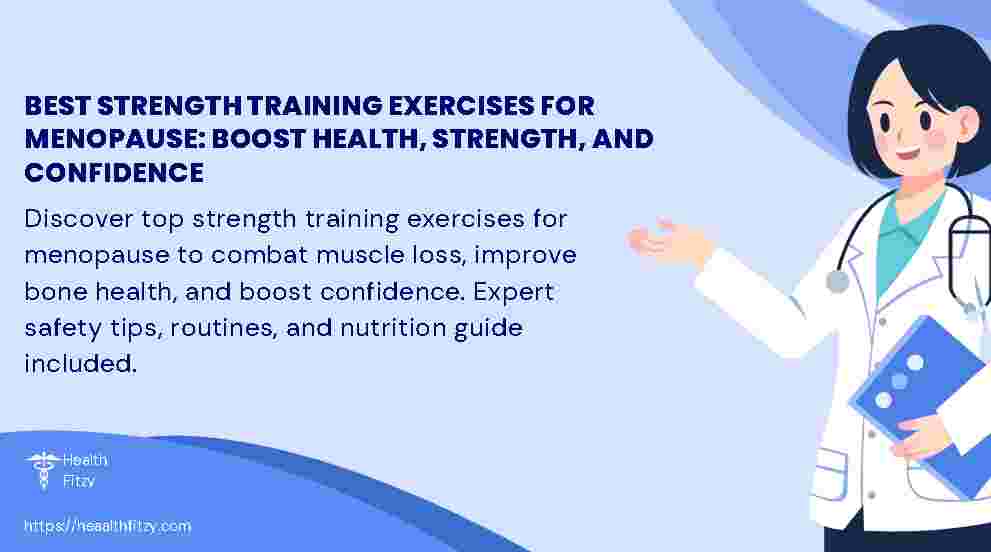Best Strength Training Exercises for Menopause: Boost Health, Strength, and Confidence
Menopause is a life-changing stage for women, frequently marked by changes in metabolism, muscle loss, decreased bone density, and hormonal imbalances. Strength training is a powerful tool to combat these challenges, improve vitality, and enhance overall well-being. In this guide, we’ll explore the best strength training exercises for menopause, backed by science and tailored for safety and effectiveness. Each step is explained in detail to help you build a sustainable routine.
Why Strength Training Matters During Menopause
As estrogen levels decline during menopause, women face increased risks of osteoporosis, weight gain, and reduced muscle mass. Strength training counteracts these effects by:
- Preserving lean muscle mass to boost metabolism.
- Strengthening bones to reduce fracture risk.
- Improving balance and coordination to prevent falls.
- Enhancing mood and reducing symptoms like hot flashes and fatigue.
Let’s dive into the best exercises to prioritize during this stage of life.
Safety First: Key Tips for Menopausal Women
Before starting, keep these guidelines in mind:
- Consult your doctor if you have osteoporosis, joint issues, or other health concerns.
- Warm up for 5–10 minutes with light cardio (e.g., brisk walking) to prepare muscles and joints.
- To prevent injury, pay attention to form; begin with less weights and work your way up.
- Rest 48 hours between sessions to allow muscle recovery.
The 7 Best Strength Training Exercises for Menopause
1. Squats (Bodyweight or Weighted)
How to Do It:
- Stand with feet shoulder-width apart.
- Maintaining knees over toes, lower hips back and down as though seated in a chair.
- Press through heels to return to standing.
- Add dumbbells or a kettlebell for resistance as you progress.
Why It Helps:
Squats build lower-body strength, improve balance, and protect hip and knee joints—critical for maintaining mobility.
2. Deadlifts (Dumbbell or Barbell)
How to Do It:
- Hold weights in front of thighs, hinge at the hips, and lower torso while keeping back flat.
- Engage glutes to return to standing.
Why It Helps:
Deadlifts improve posture and lessen back discomfort by strengthening the posterior chain, which includes the glutes, hamstrings, and lower back..
3. Push-Ups (Modified or Standard)
How to Do It:
- Start on knees or toes, hands slightly wider than shoulders.
- Lower chest toward the floor, then push back up.
Why It Helps:
Push-ups enhance upper-body strength, protecting shoulders and improving functional fitness for daily tasks.
4. Plank with Shoulder Taps
How to Do It:
- Hold a forearm or high plank position.
- Stabilize your core and tap one hand on the other shoulder.
Why It Helps:
This exercise builds core stability, reduces belly fat, and improves posture—key for combating menopausal weight shifts.
5. Step-Ups
How to Do It:
- Step onto a sturdy bench or platform with one foot, driving through the heel.
- Step back down and alternate legs.
Why It Helps:
Step-ups boost leg strength, balance, and cardiovascular health while being gentle on joints.
6. Resistance Band Rows
How to Do It:
- Anchor a resistance band at chest height.
- Pull elbows back, squeezing shoulder blades together.
Why It Helps:
Rows counteract rounded shoulders (common with aging) and strengthen the upper back.
7. Glute Bridges
How to Do It:
- Raise your hips toward the ceiling while lying on your back with your knees bent.
- Hold for 2 seconds at the top, then lower.
Why It Helps:
Glute bridges activate the core and glutes, supporting pelvic floor health and reducing lower back strain.
Building Your Routine
- Frequency: Aim for 2–3 strength sessions weekly.
- Reps/Sets: 2–3 sets of 8–12 reps per exercise.
- Progression: Gradually increase weight or resistance every 2–3 weeks.
Pair strength training with cardio (e.g., walking, swimming) and flexibility exercises (e.g., yoga) for holistic health.
Nutrition Tips to Maximize Results
- Protein: Aim for 20–30g per meal to support muscle repair (e.g., lean meats, legumes).
- Calcium & Vitamin D: Prioritize leafy greens, fortified foods, and sunlight for bone health.
- Hydration: Drink water before, during, and after workouts to combat menopausal dryness.
Final Thoughts
Menopause doesn’t have to mean decline—it can be a time of empowerment through strength training. By incorporating these best strength training exercises for menopause into your routine, you’ll build resilience, confidence, and long-term health. Start slowly, stay consistent, and celebrate small victories. Always pay attention to your body and make necessary adjustments.
Remember: Strength is ageless, and your best years are still ahead!
Read more…
26 Expert-Recommended Health Tips
pros and cons of atkins diet: Low-Carb Benefits, Risks, and Long-Term Results Explained
pros and cons of atkins diet: Low-Carb Benefits, Risks, and Long-Term Results Explained



